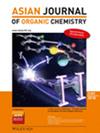The Synthesis of Nonsymmetric α‐hydroxy‐ethylidenebisphosphonic Derivatives by the Pudovik Reaction, Their Reactions, and Cytotoxic Activity
IF 2.7
4区 化学
Q1 CHEMISTRY, ORGANIC
引用次数: 0
Abstract
Nonsymmetric α‐hydroxy‐ethylidenebisphosphonic (HEBP) derivatives were synthesized by the Pudovik reaction of dialkyl α‐oxo‐ethylphosphonates (DAOEPs) and P‐reagents, such as dialkyl phosphites, alkyl phenyl‐H‐phosphinates (APHPs) and diarylphosphine oxides to make available a new family of compounds with two different P‐functions. Performing the addition of APHPs to DAOEPs in the presence of 40% of the diethylamine catalyst, the primary adducts rearranged to the mixture of the corresponding phosphonoyl‐phosphonate and phosphoryl‐phosphinate. Acylation of the HEBPs led to the formation of the respective acylated derivatives. A part of the new P‐compounds was subjected to cytotoxic screening on myeloma and metastatic cell lines. Among these, two derivatives, dibutyl 1‐(butyl‐phenylphosphinoyl)‐1‐hydroxy‐ethylphosphonate 4a and tetrabutyl α‐acetyloxy‐ethylidenebisphosphonate 8c, demonstrated the strongest antiproliferative effects on the A2058 (metastatic melanoma) and U266 (multiple myeloma) cell lines, highlighting their potential as promising candidates for further therapeutic development. The bisphosphonic derivatives 4a and 8c reduced the viability of U266 cells by 94% and 91%, respectively

Pudovik反应合成非对称α-羟基乙基二膦衍生物及其反应和细胞毒活性
以二烷基α-氧基乙基膦酸酯(DAOEPs)和二烷基亚磷酸酯、烷基苯基h -膦酸酯(APHPs)和二烷基膦氧化物为原料,通过Pudovik反应合成了非对称α-羟基乙基双膦酸酯(HEBP)衍生物,形成了具有两种不同p功能的新化合物家族。在40%的二乙胺催化剂存在下,将apps添加到DAOEPs中,初级加合物重新排列成相应的膦酰膦酸盐和膦酰膦酸盐的混合物。hebp的酰化导致了各自酰化衍生物的形成。部分新p -化合物对骨髓瘤和转移细胞系进行了细胞毒性筛选。其中,二丁基1-(butyl-phenylphosphinoyl)-1-hydroxy-ethylphosphonate 4a和四丁基α-acetyloxy-ethylidenebisphosphonate 8c对A2058(转移性黑色素瘤)和U266(多发性骨髓瘤)细胞系显示出最强的抗增殖作用,突出了它们作为进一步治疗开发的有希望的候选物的潜力。双膦衍生物4a和8c分别使U266细胞的活力降低94%和91%
本文章由计算机程序翻译,如有差异,请以英文原文为准。
求助全文
约1分钟内获得全文
求助全文
来源期刊

Asian Journal of Organic Chemistry
CHEMISTRY, ORGANIC-
CiteScore
4.70
自引率
3.70%
发文量
372
期刊介绍:
Organic chemistry is the fundamental science that stands at the heart of chemistry, biology, and materials science. Research in these areas is vigorous and truly international, with three major regions making almost equal contributions: America, Europe and Asia. Asia now has its own top international organic chemistry journal—the Asian Journal of Organic Chemistry (AsianJOC)
The AsianJOC is designed to be a top-ranked international research journal and publishes primary research as well as critical secondary information from authors across the world. The journal covers organic chemistry in its entirety. Authors and readers come from academia, the chemical industry, and government laboratories.
 求助内容:
求助内容: 应助结果提醒方式:
应助结果提醒方式:


